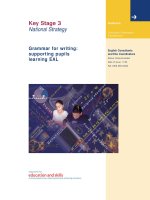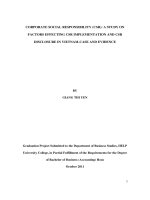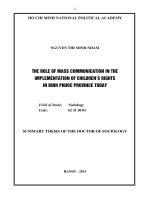EAL implementation workshop v3
Bạn đang xem bản rút gọn của tài liệu. Xem và tải ngay bản đầy đủ của tài liệu tại đây (2.24 MB, 36 trang )
VCE EAL
Implementation
briefing ― 2016
Units 3 and 4
Goal
Develop deeper understanding of the new or
revised sections of the study design
We will achieve this goal by:
• unpacking key knowledge and skills
• clarifying common misconceptions and answering
common questions
• reviewing sample responses
• considering sample teaching and learning resources
and activities
• providing activities to be completed later.
Written examination
October/November
(on a date to be
published annually
by the VCAA)
Written examination
Marks
Section A — Listening to texts
comprehension of unfamiliar spoken
text/s
20
Section B — Reading and creating
texts
an analytical response to one of two
texts selected from the English/EAL
Text List
40
Section C — Analysing argument
Part 1
demonstration of understanding of
an unseen text/s including written
and visual material.
Part 2
analysis of argument and the use of
persuasive language in the unseen
text/s.
40
Total examination score
100
Notice to
schools
Times
Reading time:
15 minutes
Writing time: 3
hours
What about note-taking?
• As a broad skill, note-taking is useful for
EAL learners across a range of contexts.
• It is one of the ways that students can
demonstrate they have understood the
spoken material in the listening task and
material in the analysing argument task.
• Note-form summaries as per current
Section C will not be used for the listening
task or analysing argument.
UNIT 1
UNIT 2
Area of study 1
Reading and creating texts
Reading and comparing texts
Summary
• Similar to current Reading and responding
• Expansion of text study to include a
area of study
comparison of the presentation of ideas,
• Refinements across area of study
issues and themes in texts
description, outcome and key knowledge and
skills
EAL students
study one text
EAL students use
the same text for
analytical and
creative responses
• Assessment includes a creative response to
a text.
Area of study 2
Analysing and presenting argument
Analysing and presenting argument
Summary
• Builds on existing study by including a more
balanced approach to the analysis and
presentation of argument and language
• Builds on existing study by including a more
balanced approach to the analysis and
presentation of argument and language
Both analysing
and presenting in
each unit
UNIT 3
UNIT 4
Reading and creating texts
Reading and comparing texts
• Similar to current Reading and responding
area of study
• Refinements across area of study description,
outcome and key knowledge and skills
• Compulsory creative response to a different
text accompanied by written explanation to
meet the outcome; option for creative
response not included in examination
• Option to complete the creative response in
oral form
• Expansion of text study to include a
comparison of the presentation of ideas,
issues and themes in texts
Area of study 2
Analysing argument
Presenting argument
Summary
• Builds on existing study by including a more
balanced approach to the analysis of
argument and language
• Builds on existing study by including a more
balanced approach to the presentation of
argument and language
• Compulsory oral presentation of point of view
accompanied by statement of intention; as per
current study, presentation of point of view not
included in examination
Area of study 3
Listening to texts – EAL students only
Summary
• New area of study to emphasise listening
skills for EAL students
• Listening task will be included in examination
for EAL students only
Area of study 1
EAL
students study
Summary
two texts. For
outcome, analytical
response to one
and creative to the
other. For SAC
respond either
creatively or
analytically to one.
Text selection — Units 3 and 4
English students study four prescribed texts:
Reading and creating texts
Reading and comparing texts
Mankiewicz, Joseph, All About Eve
Brooks, Geraldine, Year of Wonders
(multimodal)
(novel) (A)
Adichie, Chimamanda Ngozi, The
Miller, Arthur, The Crucible (play)
Thing Around Your Neck (short stories)
EAL students study three prescribed texts:
Reading and
creating texts
Both outcomes
Reading and
comparing texts
Mankiewicz,
Joseph, All About
Eve (multimodal)
Miller, Arthur, The
Crucible (play)
Brooks, Geraldine,
Year of Wonders
(novel) (A)
Combined classes
Handout
Unit 3 –
Sample course
plan
In a combined English and EAL class, teaching will
be based on the following types of activities:
• common or joint activities, where all students participate
in the same learning experiences e.g. common List 1
text
• parallel activities, where the teaching focus is similar,
but learning experiences have been tailored to the
needs of English or EAL students e.g. second text in
Unit 3, using Literature circles
• distinct or different activities, where English and EAL
students will be participating in different learning
experiences with a different teaching focus e.g. explicit
teaching of listening skills for EAL students.
EAL students receiving instruction in a combined English/EAL class
may require some additional scheduled classroom instruction.
Ideas for managing combined classes
• Use online tools to set pre-teaching or post-teaching
activities and to provide individualised feedback.
• Use group work/peer feedback as part of teaching
and learning.
• Prepare scaffolded activities and resources that can
be completed/reviewed individually.
• Prepare annotated sample responses that assist
students to understand the performance descriptors.
• Consider team teaching to support EAL learners and
share resources.
Activity
Read Unit 3 – Sample course plan and think about how you will
approach the delivery of the curriculum.
Listening to texts
Handout
Annotated list
of listening
resources
• A focus on listening skills for EAL
students.
• Literal and inferential understanding
through:
o the context and purpose of the text
o the structure and language of the text
o the delivery including intonation, stress,
rhythm, pitch, timing, volume, gesture and eye
contact
• EAL students must undertake a listening
comprehension outcome in Unit 3 and a listening task
in the end-of-year examination.
• While there is no specific outcome for listening for
EAL students in Units 1 and 2, EAL students will
need to be engaged in tasks that facilitate
development of aural skills.
Units 1 and 2 - For EAL students at least one text provided for the
assessment of Outcome 2 should be in spoken form or have a
spoken component to allow for the assessment of listening skills.
• Across the units, consider opportunities to develop
listening skills in the context of other areas of study.
Activity
Brainstorm ideas for teaching listening within the other areas of study.
Sample listening tasks
Handout
Sample
listening tasks
Audio-visual: Akram Azimi promotes
mentoring for the School Volunteer Program
Audio: Sports Unpacked
Audio-visual: Coffee culture
Spoken texts refer to texts from a range of contexts, such as conversations,
narratives, speeches, interviews, lectures, radio. Some spoken texts may be
supported by written or visual material, such as television news reports.
Activity
1. Highlight the question stems and identify the question
patterns.
2. Discuss how these could be used as models for developing
your own assessment.
When designing listening tasks:
Handout
Revised
performance
descriptors
• contextual/background information is important and
should be provided
• technical words can be defined as part of the context
• a range of question types to elicit student
understanding at different levels of performance
including open questions
• one mark does not necessarily mean one point
• number of speakers and distinctiveness of voices
• consider when you will assess expression
• opportunities to use key terms from the study design
e.g. delivery.
Analysing and presenting argument
• A balanced approach to the study of both
argument and language.
• Students compare to support the analysis of
argument and language.
• Students are not asked to evaluate which text is
better; analyse the relationship between the
language and argument.
Analyse and
10
compare the
use of argument
and persuasive
language in
texts that
30
present a point
of view on an
issue currently
debated in the
media.
A demonstration of understanding
of two to three texts that present a
point of view on an issue through:
• short-answer responses
• note form summaries.
An analysis and comparison of
argument and the use of
persuasive language in the same
two to three texts, in written form.
Texts must include written and visual material and have
appeared in the media since 1 September of the previous
year.
Note-taking is a
useful skill for
EAL learners
across a range of
contexts. It is one
of the ways that
students can
demonstrate they
have understood
the written and
visual material.
Possible ways to assess understanding
of texts that present a point of view
• List the three reasons provided for…
• What is the author’s position on…?
• Outline the main arguments using dot
points…
• What do the two authors agree on?
• Select which of the following best
represents the author’s position on…
• Summarise the author’s argument.
Sample analysing argument response
The writer contends that each of us can take action to protect lives
on Victoria’s roads. He supports a police demand that we should
ring the police to report anyone we see driving dangerously. To
strengthen this argument, he quotes the words of a senior police
officer, Superintendent Deb Robertson, who said “Ring in and
report it. Ring in, let us know.” The writer puts this call in more
colloquial language in an attempt to appeal to ordinary people:
“dob in a rogue driver.”
…
Activity
Consider how
the response
analyses both
argument and
language.
The writer supports his contention with the short forceful sentence “This year’s road
toll is unacceptable”. He uses lots of statistical evidence such as “Fifteen more
people have died…than at the same time last year” and “it has not been as high
since 2005” to add authority to his views. The reader is likely to agree that these
numbers are far too high, and that we must take action to reduce the road toll.
But the statistical evidence is not as compelling as the emotional appeals used by
the writer. When he refers to “the carnage, the twisted metal and broken glass and
bodies left at the scene of fatal accident”, the reader is forced to reflect on the horror
of road accidents.
Tips for analysing argument
• Students will need to analyse argument
and language, written and visual material
• Students should respond to the material in
front of them, not focus on splitting their
analysis evenly between argument and
language.
• Just as they do now, students will need to
make choices about what they analyse.
They can’t cover everything.
Creative responses to text
Plan creative responses to
texts by:
• analysing the text,
considering opportunities to
explore meaning
• selecting key moments,
characters, themes worthy
of exploration
• taking account of the
purpose, content, audience
in determining the selected
content and approach
• Extend a text – prologue
or epilogue written in the
style
• Fill in a gap or silence –
a moment between two
chapters or give voice to
a character’s perspective
e.g. monologue, diary
entry, letter, speech/
newspaper article in
context
• Provide new insights –
rewrite a moment from a
different narrative
perspective
Written explanation
Focus questions
•
•
•
•
•
•
•
Which story/moment/character/event is your response linked to? You may need
to make it clear at what point in the original text your response would fit.
What happens in your creative response? Mention the setting, the main
characters, key events, whose viewpoint the story is told from.
What key ideas or themes from the text does your response focus on? (e.g.
what did the writer say about culture conflict, parent-child relationships, the
difficulties of living in two cultures, bullying, multi-cultural friendships, conflict
between generations, etc.)
What form of writing have you chosen for your response? (e.g., diary of……….;
letter from …………….. to ……………..; retell the story from the viewpoint
of……..; guidelines to give advice about….)
Why do you think this would be an interesting way to create your response?
How have you tried to make your response an interesting and effective piece of
writing? Explain the decisions you have made, e.g., Whose viewpoint? What
verb tense? Use of dialogue? Use of description? Use of slang? Have you
added anything to the original story?
What would a new reader learn about the original text by reading your
response?
Sample written explanation
After reading this story, I became interested in the challenges faced by children
adopted from another country, who might feel confused about their own identity
and where they belong. For the girl in this story, her reflection in the mirror
symbolised the confusion she felt. Although she loved her Australian family, she
eventually decided to explore her origins and make contact with her birth mother
in Korea.
I have written a letter from this girl (Soo Jeong / Blossom) to her birth mother,
before her trip to Korea, in which she asks the questions that have been puzzling
her for a long time, and expresses the mixture of emotions she feels. This letter
fills a gap in the text, because the story only tells us that she made contact with
her birth mother through the adoption agency.
I imagined that the writer is about 20 years old. The letter is written from first
person point of view, and I have tried to capture the “voice” of the girl in the story.
I think it would have been very hard for her to find the appropriate tone for her
letter, because she would not have known whether her biological mother would
have been happy to receive this letter or not.
Drafting
• An important skill that students need to
develop related to refining their thinking and
ideas through writing - fundamental to the
development of students’ skills as writers.
• Students need strategies for revising their
work.
• Authentication requirements are still in
place for SACs.
Improving meaning for the reader
Basic proof-reading
For example:
• Spelling
• Punctuation
• Basic sentence
structure
• Capital letters,
full stops
Activity
Reworking for stylistic effect
For example:
• Text connectives
• Communicating
more complex
ideas through
compound or
complex
sentence
structures
• Consider
relevance by
mapping topic
sentences to the
question
For example
• Quality of ideas/thinking
• Shades of meaning,
precise vocabulary
• Subtle distinctions
across the whole text
e.g. what nouns/noun
groups are used in
relation to a character
and how do they build a
picture for reader
• Condensing meaning
e.g. through
nominalisation
Brainstorm strategies that students can use for revising their work.
Reading and comparing texts
• identify meaningful connections and
areas for comparison
• explain and analyse
o similarities and differences between texts in
the presentation of related ideas , issues and
themes
o the choices made by authors to convey
particular perspectives
• compare texts to negotiate and
communicate a deeper understanding of
ideas, issues and themes
Themes, issues and ideas – what’s the
difference?
• Different ways of tackling concepts
Theme
Power
Issue – problematises
the theme
Exploitation of power
Idea – unpacks the
theme in relation to the
text/takes a perspective
That power can be a corrupting
force
Caitlin Penrose, 2015









